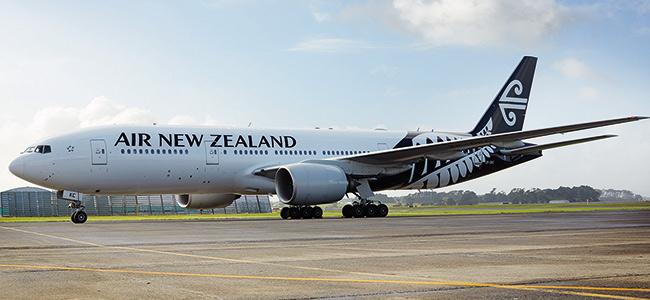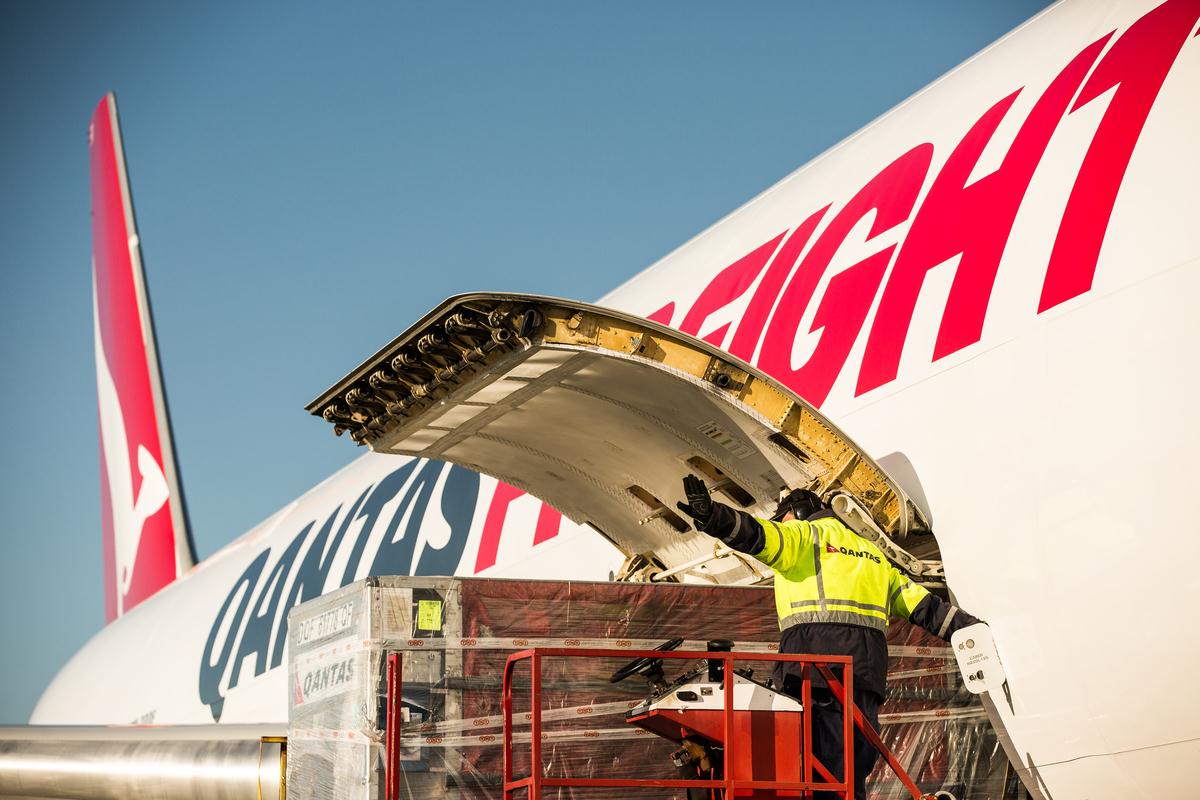The battle for air cargo in Oceania looks to be heating up, with more airlines and more routes entering the fray.
At the end of last year, oneworld carriers Qantas and American Airlines expanded their commercial partnership by announcing new trans-Pacific flights. Qantas launched nonstop Boeing 747-400 flights from Sydney to San Francisco on December 18, 2015, while AA began flying daily from Los Angeles to Sydney using 777-300ERs on December 19.
“Subject to final government approvals, Qantas Freight will be working closely with American Airlines in Australia and the USA to maximize freight opportunities in these key markets,” says Nick McGlynn, chief operating officer of Qantas Freight. “The new AA services will add capacity that we can sell to our customers at both ends and likewise, AA will be able to sell onto the QF network.”
 American says that it has had a long-standing interline relationship with Qantas, moving over a million kilos in the past year. This number is expected to increase with the new and upcoming routes AA has planned, according to Jim Butler, president of American Airlines Cargo.
American says that it has had a long-standing interline relationship with Qantas, moving over a million kilos in the past year. This number is expected to increase with the new and upcoming routes AA has planned, according to Jim Butler, president of American Airlines Cargo.
“Our new joint business on the passenger side will give us unprecedented opportunities to work together more closely and provide immense value for our customers, both passengers and cargo alike,” says Butler. “This route is a very important addition to the network going forward that we will build throughout 2016. We’re incredibly pleased with the capacity from our 777-300ER in this market and the customer support we’ve received these first few weeks of service.”
Butler adds that some of the most common things carried on the Sydney flight so far include car parts and perishables such as meat, fruit and flowers northbound, and pharmaceuticals and general consumer items southbound.
As part of the expanded partnership, AA will also launch flights from Los Angeles to Auckland on June 25, 2016, with a 787-8. This will be the sixth trans-Pacific route added by the airline over the past three years.
“We’re extremely excited about the opportunity to broaden our network into New Zealand and grow our Asia-Pacific footprint,” says Butler. “With this route, we can transport cargo to significantly more locations – a noteworthy jump in reach for our customers in the Pacific, especially since there is demand year-round in and out of the destination.”
According to Butler, even as an offline market for AA, New Zealand is a regular recipient of interline cargo and is a big exporter of perishables. “Just this past holiday season, we worked with a New Zealand-based partner to move lamb from Los Angeles to London Heathrow, a popular commodity in Europe during the Christmas holiday,” he says. “With the direct service, we’ll also be able to offer more access to Miami and Latin America to customers in New Zealand.”
Meanwhile, the country’s own flag carrier, Air New Zealand, is also working more closely with its Star Alliance partner United Airlines on the trans-Pacific trade lane. In December 2015, Air New Zealand launched flights between Auckland and United’s hub in Houston with 777-200ERs, while United is scheduled to fly a 787-8 from San Francisco to Auckland from July 2016, upgrading it to a 787-9 for the winter season.

Air New Zealand also launched thrice-weekly trans-Pacific flights to Buenos Aires in December 2015 with 777-200ERs, and the airline is hoping to play an increasingly important role in facilitating growing trade between China, New Zealand, Australia and South America, as part of recently ratified free-trade deals.
“We’ll continue to promote our new South American gateway that makes it possible for both the Chinese and Argentinian business communities to unlock the value chain that our short air bridge has established,” says Daniel Kinney, international sales manager for cargo at Air New Zealand. “For example, it takes the equivalent of just one day’s flying time from Buenos Aires to reach Hong Kong, transiting via Auckland.”
Apart from the trans-Pacific market, Air New Zealand and Qantas are also not neglecting Asia, with its dense populations, emerging economies and expanding middle class.
Air New Zealand will start flying a 767-300ER from Auckland to Ho Chi Minh City on a seasonal basis from June to October 2016, which Kinney says will enable the airline to help imports of fresh produce into Vietnam.
“We’re already playing a significant role in the busy import market in China,” says Kinney. “For example, every May, you find American blueberries in China, and during the Spring Festival period, cherries from New Zealand and Chile occupy the market. Air New Zealand transports these delicate berries to the nearest customs-supervised warehouse so that the handling time can be minimized. If everything goes well, it will only take three days to transport fresh fruit from the orchards in New Zealand to the supermarkets in Vietnam by air freight.”
Qantas, on the other hand, has recently ramped up its passenger flights from Melbourne to Singapore and Hong Kong, and from Sydney to Hong Kong, offering more cargo capacity in the process.
 “Qantas Freight has taken full advantage of the additional capacity available to and from our Asian destinations and we have seen strong growth from this,” says McGlynn. “Australia’s free-trade agreements with Korea, Japan and China have opened up a wealth of opportunities for Australian producers to meet increasing demand for fresh produce in these markets. Over the past 12 months, we have transported over 50 million kilograms of freight into Asia, helping our customers access new markets to grow their businesses. In addition to the belly space, each week we operate five 747-400F services from China to the US and two freighter services from Hong Kong and Shanghai into Australia.”
“Qantas Freight has taken full advantage of the additional capacity available to and from our Asian destinations and we have seen strong growth from this,” says McGlynn. “Australia’s free-trade agreements with Korea, Japan and China have opened up a wealth of opportunities for Australian producers to meet increasing demand for fresh produce in these markets. Over the past 12 months, we have transported over 50 million kilograms of freight into Asia, helping our customers access new markets to grow their businesses. In addition to the belly space, each week we operate five 747-400F services from China to the US and two freighter services from Hong Kong and Shanghai into Australia.”
As Australia’s busiest international airport in terms of both freight and passengers, Sydney Airport has seen a flurry of new arrivals from Asia towards the end of 2015, with AirAsia X flying from Denpasar with an Airbus A330-300 in October, Xiamen Airlines flying 787-8s from Fuzhou in November and from Xiamen in December, All Nippon Airways launching 787-9 flights from Tokyo Haneda in December, and Hainan Airlines flying A330-200s from Xi’an, also starting from December. Qatar Airways is also scheduled to begin Doha-Sydney flights using a 777-300ER on March 1, 2016.
Sydney Airport says that more than 80 percent of all air freight is now carried in the bellies of passenger aircraft.
“With new airlines and more routes, particularly from Asia, air-freight tonnages are expected to continue to grow steadily,” says a spokesperson for Sydney Airport. “The Australian dollar, free trade agreements and Asian growth have also provided freight and cargo businesses with greater confidence in achieving forecast air freight growth rates.”
The airport’s Master Plan 2033 anticipates ongoing expansion to meet increased growth in air freight and logistics, and is clear on its vision despite a major hurdle.
“A government-imposed curfew between 11pm and 6am restricts freighters’ operations at Sydney Airport and poses a long-term challenge compared to curfew-free arrangements at other airports,” says the spokesperson. “However, the airport’s strategic advantage is its proximity to the Sydney CBD, key transport links and distribution facilities which ensure Sydney Airport is well-positioned to remain the key hub for air freight in Australia.”
After speaking with customers, Butler says that AA found a strong demand for goods southbound to the Oceanian region, which is “great news” and will also lend further support to the airline’s network in Southeast Asia.
“This will give us – and thus, our customers – access to destinations currently outside of the American Airlines grid,” says Butler. “In the long term, the Oceanian market presents a great opportunity for us to further develop our perishable business in the region and to support existing perishable customers in other markets. We’ve seen how much customers appreciate the increased solutions and broader coverage which we’re now able to provide in this market that relies on the speed and efficiency of air cargo.”
McGlynn is optimistic that the air-cargo market out of Australia will continue to grow as demand for Australian products and services grows, particularly in Asia.
“Australia and therefore Qantas is in a great position to be able to meet the strong demand from Asia in the years ahead,” he says. “E-commerce continues to grow inbound and outbound for Australia, while also disrupting the air-freight market globally. We will continue to work with our customers on the opportunities presented by this change.”
By Jeffrey Lee
Asia Cargo News | Hong Kong



